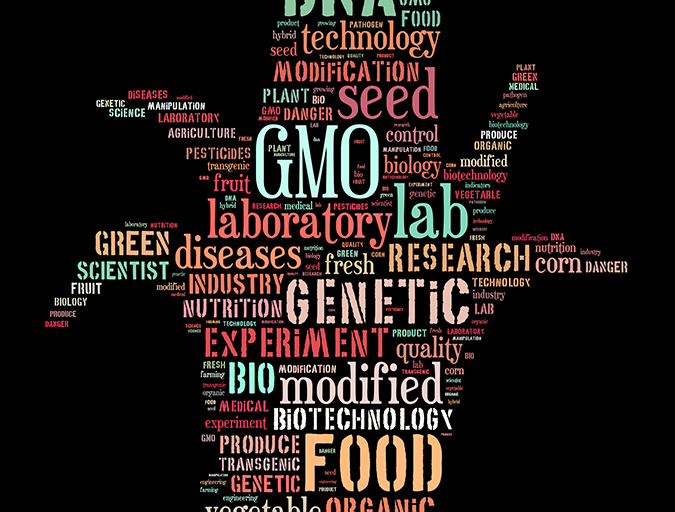Advanced science provides solutions to food and nutrition security, environmental impacts, biodiversity and the crucial omega-3 gap

Philosopher and baseball legend Yogi Berra once said, “If you don’t know where you are going, you’ll end up someplace else.”
The discussion about genetically engineered foods is fraught with such surprise destinations. Rudimentary online research shows that, in discussions about genetically engineered foods, hyperbole is commonplace, assertions masquerade as facts and antagonists are indignant over the duplicity and malfeasance of the other guys. The tone of the conversation led sustainable business writer Marc Gunther to summarize his reluctance to address genetically engineered food: “People tend to be for ’em or agin’ em, and for whatever reason, most aren’t open to listening to arguments that challenge their settled view.”
In earlier articles (here and here) I proposed that we might redirect the conversation by first establishing how we go about assessing the role of genetic engineering in agriculture. Then, armed with an approach, we might more equably delve into our assessments.
To assess the role of genetic engineering in agriculture, a required first step is to state what we want from our agricultural systems. Frequently, those wants take the form of a wish list with dozens of entries. Agriculture is vexed because it lacks a succinct description of where it should be going.
If there is one truth, it’s that in the ocean or on the land, whether plant or animal, genetically engineered or not, all agriculture causes environmental impacts.
By contrast, with pharmaceuticals we concisely say that we want drugs to treat or cure diseases. This is simultaneously simple but not simple-minded. Even with all its inherent complexity, in medicine it’s clear where you are supposed to be going and you’ll know if you end up someplace else.
Here’s my proposal for a similar statement in agriculture: Our aquaculture and agriculture systems should produce more and more nutritious food in ways that do not degrade the planet’s ability to continue to provide the food we need in the future. This gives us the framework with which we can assess the proper role of genetic engineering in agriculture.
Safe or not? The system for how we tell the two apart
In the United States, regulation of genetically engineered plants occurs through a process called the Coordinated Framework for Regulation of Biotechnology, first written in 1986 and revised in 1992. The framework distributes regulatory authority to three agencies: The USDA regulates release of seeds to be planted in the environment; the EPA overlays another set of regulations for crops specifically modified so they kill pests; and the FDA has responsibility for the safety of all food, food ingredients and animal feeds that enter commerce.
In the case of genetically engineered products, the FDA has an additional pre-market consultative process to ensure safety. Though it is voluntary, all current genetically engineered products on the U.S. market have gone through the process.
Safety is a legitimately problematical concept. Difficulty arises because, without being overly glib, safety is what we say it is. That’s not to say it is capricious; limits and boundaries are chosen prudently but they are choices rather than absolutes. For example: Our food regulations say that certain pathogens must not exceed a certain level. We don’t make an absolute statement that they must be demonstrably absent. From a scientific perspective, it’s not possible to make such a determination. Pursuing absolute safety isn’t fruitful because, quite simply, it doesn’t exist.
“Safe enough,” however, does exist and, it is worth our effort to find it. With “safe enough” we specify limits ― minimums for what we want and maximums for what we don’t. We have tests and assessments in place to ensure we don’t transgress the boundaries we establish. Setting boundaries and ensuring their respect is, generally, the purview of regulatory agencies.
From a food safety point of view, the FDA has chosen its “safe enough” standard. It acts with an a priori presumption of safety for new varieties. They apply a consistent approach in assessing foods resulting from genetic hybridization, breeder-imposed genetic selection, genetic changes educed by chemical or radiological mutagenesis and genetic changes mediated through genetic engineering. This is an approach validated by many different scientific organizations worldwide such as the U.S. National Academy of Sciences (a summary of the recent 388 page NAS report is here); the American Association for the Advancement of Science; the World Health Organization and the European Food Safety Agency.
Environmental safety
We must have food and agriculture provides it. If there is one truth, it’s that in the ocean or on the land, whether plant or animal, genetically engineered or not, all agriculture causes environmental impacts. Thus, the proper measure of stewardship in agriculture can’t be the absence of environmental effects. Quite reasonably, however, we should expect our agricultural system to employ practices that minimize those adverse environmental effects.
Choosing which environmental effects to minimize is hard to do. Because we lack consensus on what we do and don’t want from agriculture, we’re left with everything being as important as everything else. But when everything is a top priority, you don’t truly have any priorities at all. This brings us back to Yogi’s conundrum so let’s help ourselves by stating where we want to go.
To start, we need to add some detail to the thought that aquaculture and agriculture systems should produce more and more nutritious food in ways that do not degrade the planet’s ability to continue to provide the food we need in the future. I list here a few important considerations as we assess the desirability (or its lack) of advances and changes in agriculture. No list is perfect, and yours may be different from mine. But addressing these five areas will go a long way to striking a balance between food supply needs and the environmental effects of raising that food.
Food security. More calories will be needed to feed the world’s expanding population. Desirable new agricultural products will provide more food.
Nutrition security. Health and wellness are about more than quantity of calories; quality is equally important. We need food that enhances health through better nutritional content.
Improvements over incumbent practices. Growing crops in the future should offer improvements over the way they are grown now. This could happen in many ways such as lowering the inputs needed (fertilizer, water, space); increased productivity without increasing resource requirements; lower costs; reduced discharges; reduced antibiotic use; increased survival rates and lower feed-conversion ratios. In cases where new introductions provide poorer environmental effects than those they would replace, it’s reasonable to reject them.
Solutions to environmental problems. The holy grail here is imparting the ability to fix nitrogen to non-leguminous crops. Others are disease resistance, drought tolerance, adaptation to acidic soil and adaptation to acidic water.
Biodiversity retention. All agriculture reduces biodiversity. Our aspiration should be to achieve some of the goals above without diminishing biodiversity more than our current practice does. What would be even better is to achieve these goals while also improving biodiversity.
Applying a fresh view
Let’s use these considerations to look at one trait at the center of the genetic engineering kerfuffle, herbicide resistance (HR).
Most people don’t like weeds, generally, but not enough to do much about them. If you’re a farmer, you have no choice: They gotta go. Weeds consume sunlight and nutrients the farmer would rather see devoted to the crop.
To control weeds on non-HR crop fields, herbicides are used but only prior to germination. After germination, weeds are mechanically removed and this is generally done through the labor-intensive and time-consuming practice of tilling fields. For a farmer, HR simplifies weed control by allowing the farmer to spray throughout the growing season.
Choosing which environmental effects to minimize is hard to do. Because we lack consensus on what we do and don’t want from agriculture, we’re left with everything being as important as everything else.
Of the genetically engineered HR crops almost all are resistant to the herbicide glyphosate. Since entering production, glyphosate use has increased notably. And, although herbicide application on all crops (genetically engineered or not) is increasing slowly over time, the total amount of herbicides applied per acre of genetically engineered crops (maize, cotton beans) isn’t rising any faster than non-engineered counterparts (rice, spring wheat, winter wheat) (see here).
That means the profile of herbicides used has migrated from others to glyphosate. An important question to ask is whether the herbicides glyphosate replaces are poorer choices; that appears not to be so. There are, however, two important areas where herbicide-resistant crops (whether developed through genetic engineering or classic breeding) evoke notable changes.
The first is with the appearance of HR weeds. Herbicides themselves do not create resistant weeds. But repeated spraying exerts genetic selection pressure that alters the composition of weed populations.
It happens like this. Natural and very rare variants exist unnoticed in weeds and, for that matter, in any type of population. When a recurring selective pressure confers an advantage to individuals that manifest some rare variant, the representation of the variation increases within the population. For instance, if one in a million weeds is naturally resistant to an herbicide it is, essentially, undetectable. If you now spray a few million weeds with the herbicide, seeds from the naturally resistant weed will make resistant weeds a bigger proportion of the next generation. Repeated successive spraying eventually results in a problematical HR-resistant weed population.
HR weeds were an inevitable outcome of HR crops being used exactly as they were intended. The appearance of resistant weeds can be delayed through management practices but widespread spraying of an herbicide exerts inexorable pressure for the genetic selection of herbicide-tolerant weeds.
Herbicide-tolerant weeds, predicted in theory, have now been shown in practice. In recent findings, 159 weeds were discovered that show resistance to the class of herbicides called ALS inhibitors. The same study identified 36 weeds resistant to glyphosate. ALS-resistant crops arose through traditional breeding; resistance to glyphosate occurred through genetic engineering.
As I mentioned earlier, weed control can happens in a few ways. Aside from herbicides there is the age-old practice of tilling. Turn up the earth where the weeds are and they die. Simple enough but that’s not all that happens. While the weeds may be gone, tilling also comes with a price. It increases runoff of top soil and nutrients thus harming both the field itself and the watershed it leeches into; it diminishes water uptake and retention; reduces carbon sequestration; diminishes soil microbe biodiversity and compacts the soil.
For the farmer avoiding the work and the expense of tilling to control weeds is accompanied by further benefits of avoiding tilling’s adverse effects on the soil. The response of farmers is understandable. Scientists from the USDA and the EPA note: “. . . results indicate that HT soybean adoption has a positive and highly significant impact on adoption of conservation tillage amongst U.S. soybean farmers. This suggests that farmers who adopt HT soybean seeds are also more likely to adopt conservation tillage systems than farmers using conventional seeds.”
Summarizing our very short test of HR crops against the five criteria, we find a bit of a mixed bag.
- HR crops increase soil microbe biodiversity through expanding no-till farming.
- But, they diminish the biodiversity of other plants that are considered weeds.
- HR crop use leads to HR weeds.
- The herbicides used with HR crops are the most benign choices available. As HR weed populations increase, new generations of HR crops will be developed with resistance to more unattractive herbicides.
- HR crops lead to adoption of environmentally favorable no-till farming.
In looking at these, they have nothing to do with genetic engineering. Herbicides applied to non-engineered HR plants like sunflower evoke the same outcomes as herbicides sprayed onto genetically engineered HR crops. Nothing is special about the genetic engineering.
The question before us is: Do we want herbicide-resistant crops at all? The answer will apply no matter how the trait was acquired.
An output trait ― omega-3 fatty acid production
Unlike input traits whose benefits are seen mostly (or completely) by farmers, output traits are those that have some effect on consumer experience such as better taste, better nutrition or longer shelf life. This is the case with plants genetically engineered to make the omega-3 fatty acids EPA and DHA. Though not yet commercially grown, many groups (University of Rathamsted, a BASF and Cargill partnership, Dow) have plants in field trials in the oilseed crop Camelina sativa or canola genetically engineered to make EPA, DHA or both omega-3s.
Though many common crop plants make an omega-3 called ALA, humans convert ALA very inefficiently into the important actors, EPA and DHA, that provide us with many health benefits. EPA and DHA are quite unique in being available only from marine sources where they are produced by algae in marine phytoplankton. The algae are consumed by filter feeders which are, in turn, eaten by other animals as they make their way up the food chain into fish such as menhaden, anchoveta and others that are captured and rendered to provide us with the omega-3-rich fish oils used both in aquaculture feeds and human nutritional supplements.
The wild fish rendered to provide omega-3s are harvested at capacity and have been since the 1990s and harvest levels cannot increase. So, with an increasing population and fish oil production maximized, the per capita availability of omega-3s is continually decreasing. This is the problem that served as impetus for genetic engineering crops to synthesize EPA and DHA. How do we use the five criteria to assess these crops?
Food security. Carnivorous fish, especially coldwater species, require omega-3s in their diets. As it now stands, aquaculture has a production ceiling through its dependency on wild fish to supply omega-3s. For aquaculture to reach its potential in our future food supply, dependency on marine sources of omega-3s must be broken. Plant-based omega-3 production offers the path to breaking that dependency.
Nutrition security. Omega-3s are important to human health. Faced with diminishing omega-3 availability, the engineered plants make it possible to expand production that can be used for human supplements. Additionally, with the dependency on marine ingredients broken, aquaculture can expand and we will see greater fish production with its attendant health benefits.
Improvements over incumbent practices. One of the current solutions to diminishing omega-3 availability is to include less of them in fish diets, which of course reduces the amount of omega-3s in the fish we eat. A plentiful supply of omega-3s could reverse that trend to our aggregate benefit. It’s worth noting that not all fish accumulate meaningful amounts of omega-3s but, for the subset that does, new sources are promising.
Solutions to environmental problems. Again, reducing pressure on wild fisheries seems altogether good. Furthermore, resources required for fish farming are substantially less than for terrestrial-animal agriculture, so a switch to more fish-based diets is environmentally favorable.
Biodiversity retention. Even if no marine ingredients were included in aquaculture diets, the capture of wild fish might not be reduced. Fish oil and fishmeal are used in other agricultural sectors that would likely continue to use rendered fish products. Maybe the best way to view this is that land-based omega-3 production maintains but doesn’t improve biodiversity.
On balance, at least with these criteria, it looks as though plant-based production of EPA and DHA is quite beneficial. I have a bias that should be stated. For a long time, I’ve advocated for using non-marine omega-3s as ingredients in aquaculture feeds. I had a dog in that hunt for a long time when I worked for Verlasso. Now, with no vested interest in any particular solution or solution provider, I continue to believe that aquaculture must break its dependency on marine ingredients to achieve sustainable growth.
Where does all of us leave us? Gunther’s pessimistic comment comes back to mind and I hope that, perhaps, a focus on desired outcomes and how to achieve them can lead our thinking and improve the discourse on the value we find (or don’t) in genetic engineering crops.
In part 4, I’ll address transgenic animals in agriculture. This is a case where aquaculture, rather than terrestrial agriculture, is leading the discussion of the future of food production.
Now that you've reached the end of the article ...
… please consider supporting GSA’s mission to advance responsible seafood practices through education, advocacy and third-party assurances. The Advocate aims to document the evolution of responsible seafood practices and share the expansive knowledge of our vast network of contributors.
By becoming a Global Seafood Alliance member, you’re ensuring that all of the pre-competitive work we do through member benefits, resources and events can continue. Individual membership costs just $50 a year.
Not a GSA member? Join us.
Author
-

Scott Nichols
Scott Nichols is the founder of Food’s Future, LLC a consultancy that helps clients build new ventures that accelerate the expansion of sustainable aquaculture. He is a regular speaker and writer on the role of aquaculture in our future food supply and is a member of the board of directors at the Aquaculture Stewardship Council.
Tagged With
Related Posts

Innovation & Investment
Aquaculture Exchange: Scott Nichols, Food’s Future
Scott Nichols speaks to the Advocate about the launch of his own consultancy, Food’s Future, about groundbreaking innovations at Verlasso and about the role of aquaculture in a rapidly changing world — one in need of collaboration and new ideas.

Innovation & Investment
Aquaculture Exchange: Ron Stotish, AquaBounty Technologies
Ron Stotish, CEO of AquaBounty Technologies, discusses being the first to produce a genetically modified (GM) farmed salmon deemed safe for consumption, the controversy surrounding his company's product and the potential of biotechnology.

Responsibility
On GM foods, part 1: Let’s move this unproductive conversation forward
In the first part of a series on genetically modified foods, independent advisor Scott Nichols discusses the simplistic decision behind product labels and the more complex question of what could and should be the outcomes of its use.

Responsibility
On GM foods, part 2: Let’s talk about what truly matters
With entrenched positions on GM foods, it is difficult to change the conversation, but change it we must. A perpetually contentious climate doesn’t serve us well and we must abandon the current paradigm to define a new framework that facilitates more useful discussions.


